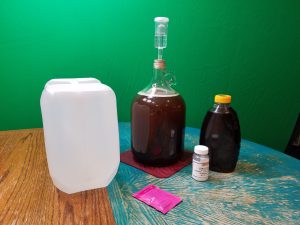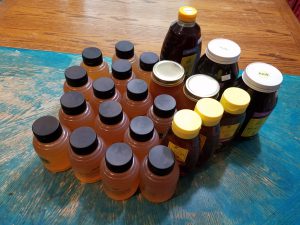 What is mead? Simply put, mead is wine. Honey wine. Possibly, no, probably, the oldest alcoholic beverage in existence. Many people have written about it and if you really are interested, I suggest Brewing Mead: Wassail! In Mazers of Mead by Robert Gayre for a very detailed history, or for more of a cursory history (and an overall great read on making mead), check out The Compleat Meadmaker by Ken Schramm. Both books are very well written and I would recommend either, although the second might be more accessible to beginners and spends more time talking about making mead.
What is mead? Simply put, mead is wine. Honey wine. Possibly, no, probably, the oldest alcoholic beverage in existence. Many people have written about it and if you really are interested, I suggest Brewing Mead: Wassail! In Mazers of Mead by Robert Gayre for a very detailed history, or for more of a cursory history (and an overall great read on making mead), check out The Compleat Meadmaker by Ken Schramm. Both books are very well written and I would recommend either, although the second might be more accessible to beginners and spends more time talking about making mead.
Throughout history, both honey and mead have played important roles. In ancient Egypt for example, taxes could be paid in honey. In ancient Greece, it was a sign of fertility. Its influence and use can be seen in many things now, from candles to beauty products. From beverages, to candies, to even pizza and meats. We even see its influence in our language.
“Within many cultures including Welsh, German and Scandinavian mead was often consumed during the wedding celebration as a toast to the bride and groom. After the wedding the couple was given enough mead to continue the toasting for one month following the wedding, or one cycle of the moon – hence the term “honeymoon” – One month of honey wine.” per Meadist.com
Mead can be sweet, dry, spicy, fruity. Hell, I’ve even had a smoky one. It can be made with fruits (melomel), spices, grains, or blended with other liquids. As with all recipes, the phrase “garbage in, garbage our,” really does apply here, as the quality of ingredients will make all of the difference. Meads come in various different forms, from straight mead, to cysers, pyments, braggots, and many, many more, and can be found on the shelf in many of the same stores that sell beer and wine across the country. As the beverage witnesses its current revival, many restaurants are offering it as well. For example, if you are in the Long Beach, California area, I recommend checking out Great Society on Broadway.
But what IS mead?
 The easiest recipe for mead is just honey, water, and yeast. Oh. And time. Lots of time. Mead making, or any kind of wine making for that matter, is not for the impatient. Your initial fermentation process can take anywhere from a week or two to around a month by itself. After the initial fermentation process, you can add ingredients to flavor, or just let it clarify. Finally, there is an aging step, which you can do in bulk in your larger fermentor, or just move it to bottles where it can sit until you remember it. Some meads may be drinkable right after clarification, but that last step, the aging, will produce a far better result, I promise.
The easiest recipe for mead is just honey, water, and yeast. Oh. And time. Lots of time. Mead making, or any kind of wine making for that matter, is not for the impatient. Your initial fermentation process can take anywhere from a week or two to around a month by itself. After the initial fermentation process, you can add ingredients to flavor, or just let it clarify. Finally, there is an aging step, which you can do in bulk in your larger fermentor, or just move it to bottles where it can sit until you remember it. Some meads may be drinkable right after clarification, but that last step, the aging, will produce a far better result, I promise.
So, what do I need to make my own?
A single gallon of mead averages me about $30 (US) and produces about three 750 ml bottles (I started off sanitizing and reusing liquor bottles that I cork and then screw the top on over the cork). There is usually also just enough left over to taste at every step of the way, which is good for quality control, but there is just no replacement for proper aging, so expect the flavor to change quite a bit! Each bottle is typically a night or two’s worth of mead, about four – eight ounce glasses.
 Basically, aside from raw ingredients (again: honey, yeast, and water) you will need a carboy – a container to ferment your soon-to-be tasty beverage in, a rubber stopper, and an airlock. These last two items allow gas from the fermentation process to escape but prevents other things, such as bacteria and dust, from getting into the must, or fermenting liquid. You can find a cheap kit at Amazon here that has all of those things. That is all you really need to get started making mead. You will need more things down the line – as in a second carboy to move your now fermented beverage to after the bubbling has stopped, and some method of transfer, but that is really all you MUST have for your must.
Basically, aside from raw ingredients (again: honey, yeast, and water) you will need a carboy – a container to ferment your soon-to-be tasty beverage in, a rubber stopper, and an airlock. These last two items allow gas from the fermentation process to escape but prevents other things, such as bacteria and dust, from getting into the must, or fermenting liquid. You can find a cheap kit at Amazon here that has all of those things. That is all you really need to get started making mead. You will need more things down the line – as in a second carboy to move your now fermented beverage to after the bubbling has stopped, and some method of transfer, but that is really all you MUST have for your must.
Some other tips for those of you interested. Use stainless steel for all brewing. ALL BREWING. If you are going to heat anything for your concoction, stainless steel will not impart any flavor to the final product. The only time I let wood touch my meads is when it goes into a barrel or I use chips or a spiral to impart that flavor. I’ve used both glass and plastic carboys and plastic fermentation buckets, and have not noticed a huge difference in taste, but that is me, and many people would recommend against it. If you do choose to use plastic, make sure it is food grade and BPA free.
Ingredients
We’ll talk about actually making the mead later, but lets talk about two of the ingredients right now. I will spend a whole separate post on the third, and most important ingredient, Honey, at a later date.
Water
Your mixture is going to be about two thirds H20, so make sure you choose good water. Your tap water is designed to kill biologicals in it, and the chemicals in it MAY kill your yeast. I recommend a bottled spring or distilled water, although do your own tests and see.
Yeast
Yeast is what does all the work. Turning all of the sugar into alcohol. You can use the same yeast you use to make your bread, but you will end up with a bready-tasting mead. Many people recommend a wine or champaigne yeast for making mead, and Lavlin D-47 or Lavlin EC-1118 are perfect for this. I have moved to using Safbrew T-58 myself, a yeast designed more for Belgian style beers, as I enjoy the taste it imparts, but that is me.
That’s all for now, folks
Any questions, feel free to drop me a line. I plan on adding some recipes, a discussion on honey, more on processes, and all kinds of things in the future, so if you have something you would like to discuss, feel free to ask!
Leave a Reply
You must be logged in to post a comment.